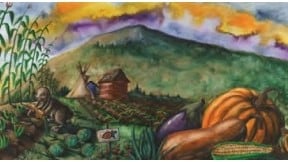Key points
- Part of health and wellness for American Indian and Alaska Native communities includes reclaiming traditional foods.
- Learn more about the Traditional Foods Project, 2008-2014.

Stories
American Indian and Alaska Native communities across the country are reclaiming traditional foods as part of the global Indigenous food sovereignty movement that embraces identity, history, and traditional ways and practices to address health.
The stories below were compiled by Chelsea Wesner (Choctaw) to help Native Diabetes Wellness Program (NDWP) understand the importance and meaning of traditional foods across Indian Country. The traditional foods stories represent Native communities across Indian Country.
Part 1: Traditional Foods in Native America
Part 3: Compendium of Traditional Foods Stories
Our cultures are our source of health
This video highlights the wisdom of cultural knowledge, including harvesting local foods and playing traditional games, in promoting health and preventing diseases like type 2 diabetes in American Indian and Alaska Native communities.
Goals
Traditional Foods Project, 2008-2014
Using Traditional Foods and Sustainable Ecological Approaches for Health Promotion and Type 2 Diabetes Prevention in American Indian and Alaska Native Communities was a 6-year cooperative agreement that championed 17 tribal programs. The tribal programs worked to restore access to local, traditional foods, and promote physical activity. The goals were to:
- Support traditional, sustainable, evaluable ecological approaches to type 2 diabetes prevention, focusing on local efforts.
- Encourage local health practices and policies to increase availability and access to local, traditional foods and physical activity.
- Revive, create, and preserve stories of healthy traditional ways shared in homes, schools, and communities.
- Engage community members for health promotion, and share stories of preventing type 2 diabetes.
While the Traditional Foods Project's cooperative agreement (2008-2014) has ended, these pages have been maintained to share stories and teachings. CDC is dedicated to devoting resources to reduce health disparities and improve health in Indian Country.
- DeBruyn L, Fullerton L, Satterfield D, Frank M. Integrating Culture and History to Promote Health and Help Prevent Type 2 Diabetes in American Indian/Alaska Native Communities: Traditional Foods Have Become a Way to Talk About Health. Prev Chronic Dis 2020; 17:190213. DOI: https://doi.org/10.5888/pcd17.190213.
- Satterfield D, DeBruyn L, Santos M, Alonso L, Frank M. Health promotion and diabetes prevention in American Indian and Alaska Native communities—Traditional Foods Project, 2008–2014. CDC Morbidity Mortality Weekly Report. 2016;65(S1):4-10. https://www.cdc.gov/mmwr/volumes/65/su/su6501a3.htm
